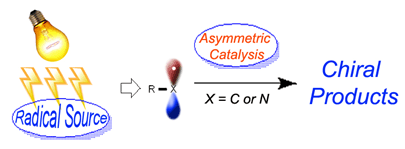| [1] (a) Parsons, A. F. An Introduction to Free Radical Chemistry, Wiley-Blackwell, Hoboken, New Jersey, 2000.
(b) Renaud, P.; Sibi, M. P. Radicals in Organic Synthesis, Wiley-VCH, Weinheim, 2001.
(c) Shang, X.; Liu, Z. Acta Chim. Sinica 2015, 73, 1275. (尚筱洁, 柳忠全, 化学学报, 2015, 73, 1275.)
[2] (a) Sibi, M. P.; Porter, N. A. Acc. Chem. Res. 1999, 32, 163.
(b) Zimmerman, J.; Sibi, M. P. Enantioselective Radical Reactions. In Radicals in Synthesis I, Springer, Berlin, Heidelberg, 2006, pp. 107~162.
[3] (a) Beeson, T. D.; Mastracchio, A.; Hong, J. B.; Ashton, K.; MacMillan, D. W. Science 2007, 316, 582.
(b) Comito, R. J.; Finelli, F. G.; MacMillan, D. W. J. Am. Chem. Soc. 2013, 135, 9358.
(c) Jui, N. T.; Garber, J. A.; Finelli, F. G.; MacMillan, D. W. J. Am. Chem. Soc. 2012, 134, 11400.
(d) Pham, P. V.; Ashton, K.; MacMillan, D. W. Chem. Sci. 2011, 2, 1470.
(e) Mastracchio, A.; Warkentin, A. A.; Walji, A. M.; MacMillan, D. W. Proc. Natl. Acad. Sci. U. S. A. 2010, 107, 20648.
(f) Devery, J. J.; Conrad, J. C.; MacMillan, D. W.; Flowers, R. A. Angew. Chem. Int. Ed. 2010, 49, 6106.
(g) Jui, N. T.; Lee, E. C.; MacMillan, D. W. J. Am. Chem. Soc. 2010, 132, 10015.
(h) Van Humbeck, J. F.; Simonovich, S. P.; Knowles, R. R.; MacMillan, D. W. J. Am. Chem. Soc. 2010, 132, 10012.
(i) Devery, J. J.; Conrad, J. C.; MacMillan, D. W.; Flowers, R. A. J. Am. Chem. Soc. 2010, 132, 6106.
(j) Rendler, S.; MacMillan, D. W. J. Am. Chem. Soc. 2010, 132, 5027.
(k) Wilson, J. E.; Casarez, A. D.; MacMillan, D. W. J. Am. Chem. Soc. 2009, 131, 11332.
(l) Conrad, J. C.; Kong, J.; Laforteza, B. N.; MacMillan, D. W. J. Am. Chem. Soc. 2009, 131, 11640.
(m) Amatore, M.; Beeson, T. D.; Brown, S. P.; MacMillan, D. W. Angew. Chem. Int. Ed. 2009, 48, 5121.
(n) Graham, T. H.; Jones, C. M.; Jui, N. T.; MacMillan, D. W. J. Am. Chem. Soc. 2008, 130, 16494.
(o) Kim, H.; MacMillan, D. W. J. Am. Chem. Soc. 2008, 130, 398.
(p) Jang, H. Y.; Hong, J. B.; MacMillan, D. W. J. Am. Chem. Soc. 2007, 129, 7004.
[4] For selected reviews, see:(a) Peñ-López, M.; Rosas-Hernández, A.; Beller, M. Angew. Chem. Int. Ed. 2015, 54, 5006.
(b) Hopkinson, M. N.; Sahoo, B.; Li, J. L.; Glorius, F. Chem. Eur. J. 2014, 20, 3874.
(c) Hari, D. P.; König, B. Angew. Chem. Int. Ed. 2013, 52, 4734.
(d) Xuan, J.; Lu, L. Q.; Chen, J. R.; Xiao, W. J. Eur. J. Org. Chem. 2013, 6755.
(e) Xi, Y.; Yi, H.; Lei, A. Org. Biomol. Chem. 2013, 11, 2387.
(f) Prier, C. K.; Rankic, D. A.; MacMillan, D. W. Chem. Rev. 2013, 113, 5322.
(g) Shi, L.; Xia, W. Chem. Soc. Rev. 2012, 41, 7687.
(h) Xuan, J.; Xiao, W. J. Angew. Chem. Int. Ed. 2012, 51, 6828.
(i) Narayanam, J. M.; Stephenson, C. R. Chem. Soc. Rev. 2011, 40, 102.
(j) Teplý, F. Collect. Czech. Chem. Commun. 2011, 76, 859.
(k) Yoon, T. P.; Ischay, M. A.; Du, J. Nat. Chem. 2010, 2, 527.
(l) Acta Chim. Sinica 2015, 73, 85. (谭芬, 肖文精, 化学学报, 2015, 73, 85.)
[5] Ruiz Espelt, L.; McPherson, I. S.; Wiensch, E. M.; Yoon, T. P. J. Am. Chem. Soc. 2015, 137, 2452.
[6] Lenhart, D.; Bauer, A.; Pöthig, A.; Bach, T. Chem. Eur. J. 2016, 22, 6519.
[7] Bauer, A.; Westkämper, F.; Grimme, S.; Bach, T. Nature 2005, 436, 1139.
[8] Murphy, J. J.; Bastida, D.; Paria, S.; Fagnoni, M.; Melchiorre, P. Nature 2016, 532, 218.
[9] Uraguchi, D.; Kinoshita, N.; Kizu, T.; Ooi, T. J. Am. Chem. Soc. 2015, 137, 13768.
[10] (a) Wang, C.; Qin, J.; Shen, X.; Riedel, R.; Harms, K.; Meggers, E. Angew. Chem. Int. Ed. 2016, 55, 685.
(b) Ma, J.; Harms, K.; Meggers, E. Chem. Commun. 2016, 52, 10183.
[11] Zuo, Z.; Cong, H.; Li, W.; Choi, J.; Fu, G. C.; MacMillan, D. W. J. Am. Chem. Soc. 2016, 138, 1832.
[12] Rono, L. J.; Yayla, H. G.; Wang, D. Y.; Armstrong, M. F.; Knowles, R. R. J. Am. Chem. Soc. 2013, 135, 17735.
[13] (a) Du, J.; Skubi, K. L.; Schultz, D. M.; Yoon, T. P. Science 2014, 344, 392.
(b) Amador, A. G.; Sherbrook, E. M.; Yoon, T. P. J. Am. Chem. Soc. 2016, 138, 4722.
[14] Shih, H. W.; Vander Wal, M. N.; Grange, R. L.; MacMillan, D. W. J. Am. Chem. Soc. 2010, 132, 13600.
[15] Huo, H.; Shen, X.; Wang, C.; Zhang, L.; Röse, P.; Chen, L. A.; Meggers, E. Nature 2014, 515, 100.
[16] (a) Arceo, E.; Jurberg, I. D.; Álvarez-Fernández, A.; Melchiorre, P. Nat. Chem. 2013, 5, 750.
(b) Arceo, E.; Bahamonde, A.; Bergonzini, G.; Melchiorre, P. Chem. Sci. 2014, 5, 2438.
[17] Huo, H.; Harms, K.; Meggers, E. J. Am. Chem. Soc. 2016, 138, 6936.
[18] (a) Nicewicz, D. A.; MacMillan, D. W. Science, 2008, 322, 77.
(b) Zhu, Y.; Zhang, L.; Luo, S. J. Am. Chem. Soc. 2014, 136, 14642.
[19] Silvi, M.; Arceo, E.; Jurberg, I. D.; Cassani, C.; Melchiorre, P. J. Am. Chem. Soc. 2015, 137, 6120.
[20] Kainz, Q. M.; Matier, C. D.; Bartoszewicz, A.; Zultanski, S. L.; Peters, J. C.; Fu, G. C. Science 2016, 351, 681.
[21] Nagib, D. A.; Scott, M. E.; MacMillan, D. W. J. Am. Chem. Soc. 2009, 131, 10875.
[22] Huo, H.; Wang, C.; Harms, K.; Meggers, E. J. Am. Chem. Soc. 2015, 137, 9551.
[23] Wo?niak, ?.; Murphy, J. J.; Melchiorre, P. J. Am. Chem. Soc. 2015, 137, 5678.
[24] (a) Cecere, G.; König, C. M.; Alleva, J. L.; MacMillan, D. W. J. Am. Chem. Soc. 2013, 135, 11521.
(b) Shen, X.; Harms, K.; Marsch, M.; Meggers, E. Chem. Eur. J. 2016, 22, 9102. |
